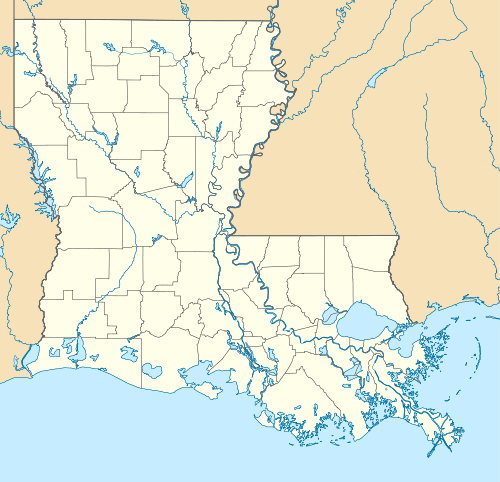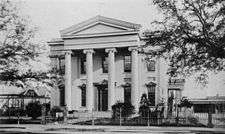Carrollton, New Orleans
|
Carrollton Historic District | |
  | |
| Location | Roughly bounded by Lowerline St., Mississippi River, Monticello Ave., & Earhart Blvd., New Orleans, Louisiana |
|---|---|
| Coordinates | 29°57′8″N 90°7′38″W / 29.95222°N 90.12722°WCoordinates: 29°57′8″N 90°7′38″W / 29.95222°N 90.12722°W |
| Built | 1840 |
| Architect | Multiple |
| Architectural style | Colonial Revival, Bungalow/Craftsman, Italianate |
| NRHP Reference # | 87001893[1] |
| Added to NRHP | November 02, 1987 |
Carrollton is a neighborhood of uptown New Orleans, Louisiana, USA, which includes the Carrollton Historic District. It is the part of Uptown New Orleans farthest up river from the French Quarter. It was formerly a separate town incorporated in 1833, and was annexed by New Orleans in 1874 (becoming the 16th Ward and 17th Ward of the city) but has long retained some elements of distinct identity.

Historically the boundaries of the city of Carrollton were the Mississippi River, the downriver border of Jefferson Parish, Louisiana, Fig Street, and Lowerline Street. As Lowerline is a small street, some people think of the neighborhood of Carrollton as extending two blocks further to the larger thoroughfare of Broadway. The area on the river side of Claiborne Avenue is sometimes referred to as "Old Carrollton". The incorporation of Carrollton creates an apparent anomaly in New Orleans street names; Lowerline is upriver from Upperline Street, which was originally the upriver boundary of another suburb annexed in the 1850s.
Civil War
During the American Civil War, Carrollton soon fell under Union control. Historian John D. Winters in his The Civil War in Louisiana (1861), reports that soldiers in Carrollton were heavy whiskey drinkers. A young officer complained that "one-fifth of the regiment keeps drunk all the time."[2] Post commander General John W. Phelps permitted the men to drink because he thought that they "must have whisky or die of country fever."[3] General Benjamin F. Butler, from time to time, issued orders forbidding the public sale of liquor. Butler's brother, Andrew J. Butler, who held no official capacity, then petitioned his brother to lift the ban. Andrew Butler monopolized the liquor trade and brought cattle into the area from Texas and flour from the North. Winters describes Andrew Butler as "a jolly, fat man who could be as hard as nails where a dollar was concerned. [He] quickly established a monopoly on all groceries, breadstuffs, medicines, and staples brought into [New Orleans]. He seized and operated a city bakery that was the only breadmaking establishment allowed in the city.[4] Many in New Orleans considered the Butler brothers "on the make," and persons needing official favors were more likely to succeed if they were on good terms with Andrew Butler.[5]
City overview
The main street is broad Carrollton Avenue, lined with live oaks, with the St. Charles Avenue Streetcar running on the "neutral ground" or central median. The streetcar barn is a block off the avenue in Carrollton, on Willow St., and the landmark Camellia Grill diner is near the corner of St. Charles and Carrollton Avenues. The old Neoclassical Carrollton court house building is on Carrollton Avenue near the Mississippi; as of 2011 it houses Audubon Charter Middle School.
The neighborhood and Avenue are pronounced "kaa-rull-ton" or "kaa-ril-tin" by residents and other uptowners, but many people from the downtown parts of New Orleans (especially those born in the mid 20th century and earlier) pronounce the names as "Karl- ton".
Tulane University and Loyola University New Orleans are just a few blocks below Carrollton, and many students, faculty, and staff live in the area and patronize the businesses there.

In addition to Carrollton Avenue and Saint Charles Avenue, the neighborhood still retains two "neighborhood main streets" of mixed residential and commercial use. Lower Carrollton centers on Maple Street, with many restaurants, coffee houses, bars, and upscale shops. Upper Carrollton has Oak Street, formerly hosting somewhat larger businesses (such as Woolworth); current businesses there range from restaurants and a hardware store to the best known of the neighborhood's live music venues, the Maple Leaf Bar.
In the Northwest section of Carrollton on Claiborne Avenue is Palmer Park, which hosts some moderate sized live music festivals each year. The park has a monument to the Carrolltonians who died in World War I. After Hurricane Katrina, Palmer Park has hosted the monthly Mid-City art market, displaced from the more severely damaged Mid-City neighborhood.
The historically predominantly African-American part of Carrollton along the riverfront has been known since the mid 20th century as "Black Pearl." Mahalia Jackson, the "Queen of Gospel music", was from the Black Pearl section of Carrollton.
This part of Carrollton is documented as the location of "Rising Sun Hall" near the riverfront in the late 19th century, which seems to have been a building owned and used for meetings of a Social Aid & Pleasure Club, commonly rented out for dances and functions. This is one proposed possible inspiration for the legendary song House of the Rising Sun. Definite links to gambling or prostitution, if any, are undocumented for either of these buildings, neither of which still exists.
Most of Carrollton has long been ethnically mixed, with "free people of color" owning homes in other parts of the town before the Civil War. Many immigrants from Germany, Ireland, and other parts of the United States settled here in the 19th century.
The post of "mayor of Carrollton" survived to the 1980s, although it was an informal one, representing the concerns of the neighborhood to the New Orleans city council.
As of 2004, the United States Postal Service still delivers mail addressed either as "Carrollton, Louisiana" or "New Orleans, Louisiana." The ZIP Code is 70118.
During New Orleans Mardi Gras celebrations, the Krewe of OAK parades through Carrollton. The Phunny Phorty Phellows krewe also holds its "parade" in Carrollton, throwing beads from the streetcar.
Education

New Orleans Public Schools and the Recovery School District serve Carrollton.
Prominent in the area is the Carrollton Courthouse, the former courthouse for the city of Carrollton (located at 719 South Carrollton Avenue). Designed by prominent New Orleans architect Henry Howard, who also designed many other notable buildings around Louisiana including Nottoway Plantation and Madewood Plantation,[6] and completed in 1855, the site served as the courthouse for Carrollton and Jefferson Parish until the town was annexed onto New Orleans in 1874.[7] Since then, the building has housed McDonogh 23 elementary school, Ben Franklin Senior High School, Lusher Elementary School's 6-8 extension (now Lusher Charter School), and Audubon Charter School.[7] The building has been vacant since 2013.[8]
There was a private school named the Carrollton Private School, founded to avoid racial integration in the 1950s.[9]
The New Orleans Public Library operates the Nix Branch Library in Carrollton Riverbend.[10] Robert Morris of the Uptown Messenger said that it was a "popular little" library.[11] As of 2011 there was a "secret gardener" who watered the flowers on the library property.[10]
References
- Carl, Jim. Freedom of Choice: Vouchers in American Education: Vouchers in American Education. ABC-CLIO, September 13, 2011.
Notes
- ↑ National Park Service (2008-04-15). "National Register Information System". National Register of Historic Places. National Park Service.
- ↑ John D. Winters, The Civil War in Louisiana, Baton Rouge: Louisiana State University Press, 1963, ISBN 0-8071-0834-0, p. 137
- ↑ Winters, p. 137
- ↑ Winters, pp. 137-138
- ↑ Winters, p. 138
- ↑ "Madewood History". Madewood.com. Retrieved 2013-03-19.
- 1 2 "NO_Old_Carrollton_Courthouse". Old-new-orleans.com. Retrieved 2013-03-19.
- ↑ Langenhennig, Susan "What's the future of the vacant Carrollton Courthouse?" The Times Picayune. May 29, 2015, Retrieved 05 October 2015.
- ↑ Carl, p. 52.
- 1 2 Sisco, Annette. "Secret Gardener tends to Nix Library: Annette Sisco." The Times-Picayune. Thursday August 11, 2011. Retrieved on March 31, 2013.
- ↑ Morris, Robert. "With Nix library reopened, Carrollton neighbors plan to help beautify it." Uptown Messenger. October 16, 2011. Retrieved on March 31, 2013.
External links
| Wikimedia Commons has media related to Carrollton, New Orleans. |
| Wikivoyage has a travel guide for Carrollton, New Orleans. |